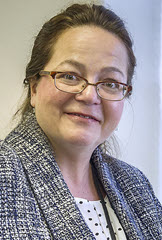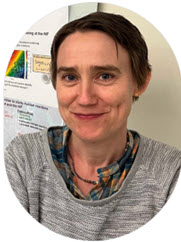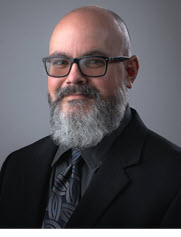Dr. Cathy Cutler
 Cathy Sue Cutler, who has served as director of the Medical Isotope Research and Production (MIRP) program at the U.S. Department of Energy’s (DOE) Brookhaven National Laboratory since 2015, has been tapped to lead a newly created Isotope Research and Production (IP) Department at the Brookhaven National Laboratory. The new department brings the components of MIRP—the Brookhaven Linac Isotope Producer (BLIP) and the Radioisotope Research and Production Laboratory (RRPL)—out of the Collider-Accelerator Department (C-AD) to align with DOE’s current classification of facilities. Under Cutler’s leadership, the new department will expand and improve the Lab’s isotope research and production to help meet the nation’s growing need for critical isotopes for medical, industrial, and national security uses.
Cathy Sue Cutler, who has served as director of the Medical Isotope Research and Production (MIRP) program at the U.S. Department of Energy’s (DOE) Brookhaven National Laboratory since 2015, has been tapped to lead a newly created Isotope Research and Production (IP) Department at the Brookhaven National Laboratory. The new department brings the components of MIRP—the Brookhaven Linac Isotope Producer (BLIP) and the Radioisotope Research and Production Laboratory (RRPL)—out of the Collider-Accelerator Department (C-AD) to align with DOE’s current classification of facilities. Under Cutler’s leadership, the new department will expand and improve the Lab’s isotope research and production to help meet the nation’s growing need for critical isotopes for medical, industrial, and national security uses.
Cutler has broad interests in nuclear medicine, radiopharmaceutical sciences, radiopharmacology, and cancer research chemistry. She joined Brookhaven Lab in 2015 from the University of Missouri, where she was a professor at the Research Reactor Center and a faculty member at the university’s Nuclear Sciences and Engineering Institute. She holds a B.S. in biochemistry and a Ph.D. in inorganic chemistry from the University of Cincinnati, where she also held a post-doctoral position in analytical chemistry.
Dr. Maria Gatu Johnson
 Dr. Maria Gatu Johnson is a principal research scientist and nuclear diagnostic expert in the High Energy Density (HED) physics group at the MIT Plasma Science and Fusion Center, where she divides her time between programmatic Inertial Confinement Fusion (ICF) research, astrophysically-relevant nuclear science experiments using the ICF/HED platform, and managing the MIT HED accelerator.
Dr. Maria Gatu Johnson is a principal research scientist and nuclear diagnostic expert in the High Energy Density (HED) physics group at the MIT Plasma Science and Fusion Center, where she divides her time between programmatic Inertial Confinement Fusion (ICF) research, astrophysically-relevant nuclear science experiments using the ICF/HED platform, and managing the MIT HED accelerator.
A primary focus of Dr. Gatu Johnson’s is plasma nuclear science-relevant basic-science experiments at the OMEGA and NIF laser facilities. As the responsible scientist for two neutron spectrometers installed at OMEGA and the NIF, she is also deeply involved in the primary cryogenic DT implosion programs at each facility. In particular, she has focused her efforts on working to understand stagnation physics in ICF implosions.
Dr. Gatu Johnson received her PhD in Applied Nuclear Physics from Uppsala University, Sweden, in 2010, working on neutron diagnostics for the JET tokamak. As the manager of the MIT HED Accelerator Facility, supervising its upgrades, maintenance, and operation since 2013, she spends a significant fraction of her time advising students in the lab, facilitating their hands-on learning experiences, educating them in best practices of laboratory safety. This lab is dedicated to diagnostic development (including calibration, testing, and development of new analysis techniques) for ICF and HED physics experiments the OMEGA, NIF and Z facilities.
Dr. Blas Pedro Uberuaga
 Blas Pedro Uberuaga, the son of a Basque sheepherder, received his BA in Physics from the University of Idaho in 1994 and his PhD in Physics from the University of Washington in 2000. He has been with Los Alamos National Laboratory ever since, first as a postdoc in Theoretical Division then as a staff member in Materials Science and Technology Division. His research has focused on using atomistic computational modeling to understand radiation damage in materials, particularly complex oxide ceramics and nanostructured materials, with an emphasis on the kinetic properties of defects. He uses methods such as accelerated molecular dynamics and kinetic Monte Carlo to discover kinetic processes and understand their potential impact on radiation damage evolution.
Blas Pedro Uberuaga, the son of a Basque sheepherder, received his BA in Physics from the University of Idaho in 1994 and his PhD in Physics from the University of Washington in 2000. He has been with Los Alamos National Laboratory ever since, first as a postdoc in Theoretical Division then as a staff member in Materials Science and Technology Division. His research has focused on using atomistic computational modeling to understand radiation damage in materials, particularly complex oxide ceramics and nanostructured materials, with an emphasis on the kinetic properties of defects. He uses methods such as accelerated molecular dynamics and kinetic Monte Carlo to discover kinetic processes and understand their potential impact on radiation damage evolution.
Dr. Uberuaga currently leads a core Basic Energy Sciences project focused on understanding the relationship between cation order and atomic transport in complex oxides, and an Energy Frontier Research Center – FUTURE, Fundamental Understanding of Transport Under Reactor Extremes – that targets the coupled effect of irradiation and corrosion on materials evolution. He is also active in projects that target scintillator discovery, plasma-materials interactions for fusion energy systems, the impact of grain boundaries on dopant segregation and defect evolution, and the development of exascale computational capabilities for studying transport in complex materials.
Over his career, Dr Uberuaga has published nearly 300 papers that have been cited over 30,000 times for an h-index of 58. He is a Fellow of the American Physical Society and of Los Alamos National Laboratory.
